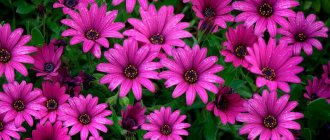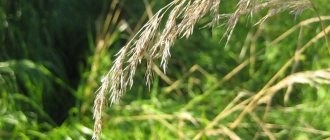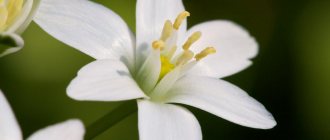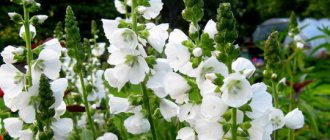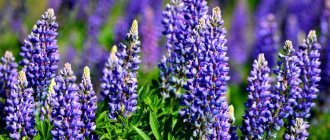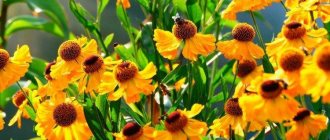The bright and elegant helenium flower grows naturally in North and Central America. It is readily grown by flower growers all over the world in their gardens. And this is not surprising, because at the end of summer the flower garden where the autumn helenium grows is dressed up with bright colors that last until frost. We invite you to familiarize yourself with the best varieties and photos of autumn helenium, when and how to plant seeds for seedlings or in open ground, in order to end up with a beautiful and bright flowerbed on your site.
By the way! If you are interested in the Lunar Sowing Calendar with favorable days for sowing helenium this year, follow the highlighted link.
Description of heleniums with photos
Heleniums are large grasses from the grasslands of Central and North America.
In perennial species, the aboveground part grows in the spring from buds formed on the underground part of the annual stem, that is, Heleniums do not have a bush in the generally accepted sense, but have closely seated independent plants (from 40 to 160 cm in height).
Heleniums look great in autumn flower beds with cereals.
The bushes have a columnar shape: strong, woody, leafy stems along the entire height, strongly branching in the upper part. Each branched shoot ends in a golden or orange flower - a basket with a diameter of up to 6-8 cm. As a result, several hundred flowers bloom on each stem. Heleniums bloom in August for a month, at the same time as rudbeckias, goldenrods and autumn daisies. The seeds ripen by October.
Growing helenium from seeds
Helenium seeds have a low germination rate, so if you already have a bush of this elegant plant growing in your garden, then it is best to propagate it by leaf rosettes or by dividing the bush, which we will write about in more detail below.
Those who want to decorate their flowerbeds with new varieties of autumn helenium and have purchased seeds in the store will be able to sow them directly in open ground in the spring or pre-grow seedlings. In any case, the planting material must first undergo stratification, that is, lie in a cold place. To do this, the seeds are mixed with wet sawdust, placed in a container and kept in the vegetable drawer of the refrigerator for one or even a month and a half.
If helenium seedlings are to be grown, the seeds are sown on the surface of the soil, the seedling container is wrapped in cellophane and placed in the same section of the refrigerator or in another place with the same temperature.
Sowing seeds in open ground
In order not to bother with seedlings, perennial heleniums are grown from seeds, sown in open ground.
Let’s write about the sowing rules step by step:
- Having chosen a well-lit place for the flowerbed, you need to dig it up, fertilizing the soil with compost or humus.
- The soil should have a neutral reaction, be nutritious, drained and light.
- The seeds are sown in furrows, the distance between which should be about 25 cm.
- The seeding depth is approximately 3-5 cm.
The plantings are sprinkled with soil, watered and mulched with humus or peat, which will protect the planting material from the cold and maintain moisture in the soil.
Sowing seeds for seedlings
When to sow helenium seeds for seedlings ? This must be done at the end of February - beginning of March, since the planting material must have time to undergo stratification. After six weeks, the container with helenium crops at home should be removed from the refrigerator and placed under artificial lighting in a warm place with an air temperature of about +20 degrees.
After two or three true leaves appear on the seedlings, they are carefully, along with a lump of earth on the roots, planted in separate small pots. This procedure is called helenium picking.
When to plant seedlings in a flowerbed
Around the end of May, when the soil in the garden warms up, helenium seedlings can be planted in open ground. The plants are pre-watered, and the bed is fertilized with compost and dug into the bayonet of a shovel.
It is better to make a flower bed for planting flowers in a sunny area, although they also grow well in the shade. However, flowering with a lack of sun will not be as abundant and bright.
How to plant seedlings correctly
The distance between heleniums in open ground should be at least 25-30 cm, so holes for planting seedlings are made with such a distance. The volume of the hole should be made so that it is twice the volume of the roots.
You will be interested to know: Calendula: planting and caring for seedlings and in open ground, when to plant, photo of the flower
The plant, together with a damp lump of earth, is taken out of the pots, placed in a hole, sprinkled with nutritious soil on top and watered. It is recommended to mulch the ground around the plantings with humus or peat.
Perennial autumn heleniums grown from seeds will bloom only next year.
Helenium autumn
Homeland - damp meadows of North America.
Helenium autumnale is a perennial plant native to the RAW (this is important!) meadows of North America, forming a tall bush. It blooms in July-September for 60 days with yellow, orange or reddish flowers.
Juvenile , it is necessary to divide often - once every 2-3 years.
Yellow and orange varieties of helenium
Gartensonne (up to 110 cm high), Chipperfield Orange (orange), Moerheim Beauty (up to 180 cm), Superbum (180 cm high), Septembersonne (160 cm high).
Tall helenium variety Moerheim Beauty
Yellow helenium varieties with red strokes
Altgold (90 cm high), Altgoldriese (110 cm high, flowers are smaller than usual - 4 cm in diameter), Goldfuchs (140 cm high).
Helenium Sombrero is a compact variety from the Mariachi variety series. The flowers are chamomile-shaped, yellow and yellow. Blooms in August-October. Bush height up to 50 cm.
Red-colored varieties of helenium
Die Blonde (170 cm high), Glotauge (90 cm high), Katharina (140 cm high, flowers 4-5 cm in diameter).
Pests and diseases
Heleniums are resistant to diseases and pests. They are exposed to diseases only if the soil in the flower bed is often waterlogged. As a result, the roots begin to rot, the flowers fade, and the plant dies.
Among the pests, Heleniums are often attacked by chrysanthemum nematodes. These worms damage flower buds and leaves. It is recommended to dig up and burn a bush affected by these pests. To protect the plant from nematodes, when planting flowers, you need to carefully inspect the ground. If worms are found, the soil is treated with slaked lime or ground sulfur. At the end of July, the plants are sprayed with Thiophos solution.
Helenium care
The natural habitats of helenium are damp, swampy areas. The root system is superficial and poorly developed.
In cultivation, Helenium varieties prefer sunny places with loose garden soils, but can also tolerate partial shade. In hot weather, watering is required; this is a moisture-loving plant. He loves feeding, it is advisable to start it in May.
Helenium autumn Sahin's Early Flowerer is a bush 90-120 cm high. The variety blooms for a very long time, from July until frost.
Outdoor care
The main thing in caring for helenium is to water and loosen the soil on time. In addition, to get a beautiful flower bed with lush, healthy plants, you need them:
- feed;
- weed;
- tie tall varieties on pegs;
- divide and replant in time;
- properly cover for the winter.
Heleniums quickly deteriorate when growing in one place, so gardeners recommend replanting and replanting the bushes every 3 years. This way they won't interfere with each other. Young plants look neater.
Pests and diseases
Helenium is rarely exposed to pests. Sometimes its leaves are affected by the chrysanthemum nematode. It is impossible to get rid of the pest. The only way is to cut off and burn all affected areas. To prevent the appearance of chrysanthemum nematodes, add a little slaked lime to the soil when planting. Also, make sure that the soil is not overly moist.
Hellenium transplantation and propagation by dividing the bush
Transplantation and propagation of hellenium by dividing the bush photo
As already mentioned, it is necessary to replant Hellenium 4-5 years after planting. A developed bush will degenerate over time in order to rejuvenate the plant and give space for development, and periodic division of the bush with replanting is required.
Carefully dig up the root and remove the bush with a lump of earth. Take a knife or shovel to cut the bush into several parts, being careful not to break the ground. Planted in deep holes up to 30 cm, at the bottom of which humus is poured. The planting level remains the same without deepening the root collar. Keep in mind that the earth will settle, try to prevent the roots from ending up on the surface, which is also very bad. Water generously to moisten the soil to the entire depth of the hole.
Sometimes they do this: they dig around the edges, separating parts of it, and leave some untouched. Since the bush has been divided, there will be room for the growth of new root buds and the plant will rejuvenate. And the separated sections are planted in a new place.
Types and varieties
There are about 30 species of this perennial in nature, but only 5 of them have been cultivated:
- Helenium autumn
(
pictured
). Reaches a height of 1 meter. Proper care promotes rapid flowering from August to October. This species has served as the basis for breeders to recreate many varieties that not only have larger flowers, but also a flowering period that extends by one to two months. To decide on the variety that is needed specifically for your garden, look at the photo and decide. The most common varieties of this species are Pumilum Magnificum, Bruno, Kupfersprudel, Butterpat. - Helenium Hoopa (H. hoopesii)
- has bright yellow flowers reaching 10 centimeters in diameter. - Gelenium Bigelow (H. bigelovii)
- reaches a height of 80 centimeters. The flowers are large, yellow, very bright. - Spring helenium (H. vernalis)
is a very unpretentious and winter-hardy species. - Hybrid Helenium (H. x.hybridum)
. It includes many hybrid varieties, the origin of which is unknown. They have different sizes, shapes and flower colors. They are all very beautiful, look at the photos. The height and duration of flowering also vary. Main varieties: Gartcnsonne, Goldlackzwer, Rothaut. - Helenium perennial
. The name speaks for itself - this is a perennial variety. Planting and caring for this variety are no different from the previous ones.
Growing and care
Helenium perennial is known to everyone as an unpretentious crop. It is often grown in places where people rarely come: country houses, summer cottages, etc. However, in order for the flower to show its full potential, some effort can be made.
The main agrotechnical measures for caring for a flower come down to applying fertilizers, weeding, watering and preparing for winter.
Watering
The basics for caring for this crop are that growth and bud formation are equally adversely affected by both drying out the soil and excessive watering. Therefore, you should carefully monitor the condition of the soil. During the summer heat, artificial watering may be required. The optimal interval between watering the soil is a week, and if perennial helenium grows in an open sunny area, then the intervals can be reduced to 3 days.
Loosening
Weeding solves two problems at once: removing weeds and improving the soil structure. Loosening the upper crust, which forms after watering, reduces water evaporation and protects the roots from drying out, while simultaneously improving the air exchange of the soil.
To simplify flower care, the surface of the earth can be mulched with a layer of peat: this will not only prevent the formation of crust, but also slow down the development of weeds.
Fertilizer
Feeding is applied three times during the growing season:
- In May-July. Add 1 tbsp of urea and potassium sulfate to a bucket of water. l. Apply the solution in a ratio of 4 liters per 1 m2.
- At the moment of active bud formation. Prepare a solution from the drug “Bud” in the amount of 1 tbsp. l. for 10 liters of water. For 1 m2 3 liters are enough. You can spray the above-ground parts of the plant with this composition.
- After flowering. Dilute 1 tbsp. l. superphosphate and 1 tbsp. l. potassium sulfate per bucket. Apply at the rate of 5 liters per 1 m2.
As flowering progresses, it is necessary to remove all dried flowers to initiate the process of formation of new buds.
Preparing for winter
After the ground organs dry out, they are cut down to soil level. This must be done so that moisture does not get through the remaining dry shoots to the renewal buds. After this, the beds are covered with a layer of mulch or lutrasil, which will protect the underground organs from freezing.
Application in landscape design
Helenium autumn is a real find for florists and landscape designers. You can easily find many options for decorating your home and garden with this bright plant that blooms profusely and luxuriantly:
- autumn helenium will perfectly cope with the role of tapeworm on a neat lawn;
- its tall varieties look wonderful in joint plantings with other perennials that bloom in the second half of summer: sapling, rudbeckia, delphinium, heliopsis;
- tall bushes of autumn helenium perfectly camouflage and cover unattractive-looking fences or parts of outbuildings;
- this flower will be an excellent background in a multi-level cascading flower bed;
- group plantings of this plant will give the garden a bright and elegant look at the end of summer or early autumn;
- Combinations of blooming autumn helenium, painted in warm colors, with snow-white paniculate phlox or autumn asters are very effective;
- Compositions with companion plants selected to match the given flower look beautiful and delicate: goldenrod, marigold, heuchera, garden yarrow;
- The brightness of autumn helenium is successfully emphasized by the ornamental grasses growing nearby.
It is worth knowing that this plant is an excellent fragrant honey plant that invariably attracts bees and butterflies to the garden.
Helenium autumn will fit wonderfully into any corner of the garden
Advice! Helenium looks wonderful and lasts a long time in autumn bouquets. However, it is necessary to cut off shoots with already blossoming flowers; the buds of this plant will not open in a vase with water.
Varietal diversity
In July, one of the most popular helenium varieties blooms - “MoerheimBeauty”. It is distinguished by the unusual bronze-red color of its flowers. The height of the helenium of the presented species reaches 90 cm.
At the end of summer you can enjoy the flowering of such varieties as:
- "BaudirektorLinne", red-brown flowers (plant height - 130 cm);
- "Waltraud", yellow-brown flowers (plant height - 80 cm);
- "Koenigstiger", yellow flowers with a red border (plant height - 120 cm);
- "Magnificum", reaches a height of 80 cm, a low-growing variety, yellow in the middle.
In autumn, varieties such as “Sonnenwunder” and “Septembergold” bloom. The first variety is distinguished by its amazingly beautiful orange flowers, while the second variety has yellow flowers.
Distribution and characteristics
Natural species are found in wet, low-lying meadows, the edges of swamps, and the edges of forests in Western America. One- and perennial hybrids are cultivated as garden crops and grown for cutting. The plant loves the sun, its water needs are also quite high, which can be provided in northern and central Russia.
Helenium flowering begins in summer and continues until the first frost (60 days). The “lush wilting of nature” in the European part of Russia does not suffer from a lack of crimson and golden flowers. A riot of colors covers the upper and middle tiers of the garden, and the greenish-gray shades of succulents dominate the flowerbeds. Helenium is a bright harmonious chord necessary for Russian autumn.
The strong woody stems of the plant are covered along the entire height with lanceolate leaves with a serrated edge. Low forms rise 30–60 cm above flower beds, large hybrids reach 90–180 cm. The sizes of single or corymbose groups of inflorescences vary slightly. Typically the baskets have a diameter of 3–7 cm, they resemble daisies with a convex central part.
The delicate aroma and abundance of pollen attract insects. No cases of allergy to the smell of helenium have been identified in humans.
The marginal flowers can be single-colored or two-colored. Their range of shades ranges from light yellow to brown. The tubular central flowers are usually yellow-brown, but red and burgundy are also found. The oblong achene has slight pubescence.
Reproduction
Helenium reproduces in two ways.
Reproduction by rosettes
Experienced gardeners recognize this method as the simplest and most effective. The thing is that these flowers have one very interesting feature - before the onset of winter, the entire plant dies, but many buds remain in the ground. Closer to spring, rosettes of leaves sprout from the buds, which are used as planting material. They are dug up, divided and planted in several pieces at a permanent place of growth.
Propagation by seeds
This method is not so effective and simple, since helenium seeds have poor germination. The way out of the situation is to sow for the winter, then the chances of getting seedlings increase.
They do it like this:
Planting in open ground is carried out in the first ten days of June, when the soil has warmed up sufficiently and the threat of frost has passed.
At the same time, plants should not be planted densely, as their root system grows quickly. For 1 m2, 4 or 5 bushes are enough, but no more.
When using this method of propagating helenium, be patient, because you will only be able to admire the flowers after two to three years.
Description of the plant
There is an opinion that the bright Helenium is named after the wife of the king of Sparta Menelaus, Helen the Beautiful. Her abduction became the cause of the long Trojan War. Probably, the yellow color of the plant’s petals evoked associations with the golden curls of a mythical beauty. But the version about the name of the flower in honor of the ancient Greek sun god Helios is considered more plausible. Red-yellow daisies in shape and color resemble the luminary of the day.
The unusual flower belongs to the Asteraceae family. To date, more than 32 of its species are known. In the wild, Heleniums are found on the North American continent. A detailed description of the plant helps to understand the specifics of caring for it.
The flowers do not have a perennial rhizome. At the end of autumn, the roots of the plant die off along with the peduncles and stems. Only the buds remain in the underground part of the annual shoot. By winter, small bushes with roots grow from them. From each such rosette a new plant is formed the next year. Independent flowers growing close to each other look like a single bush.
Depending on the type of helenium, the height of its stems ranges from 80 cm to 180 cm. The inflorescences are baskets, the diameter of which can exceed 9 cm. They can be single or collected in corymbose inflorescences. In the middle of the flower there are brown, black or yellow tubular flowers. They are framed by marginal reed flowers. The plant will decorate the area with rich yellow, red, purple, bronze and black colors.
Abundant flowering is observed from June until the first frost. Some species bloom as early as May. The color of the petals becomes brighter with the arrival of autumn, when other plants lose their colors.
A characteristic feature of helenium is its strong, pleasant aroma. The flower spreads its fragrance throughout the garden, attracting bees and other insects.
Helenium loves well-lit areas, but can also develop successfully in partial shade.
Helenium is a hardy perennial. Wintering
Most plant varieties are grown in zones 3–8 according to the classification proposed by the United States Department of Agriculture (USDA). The northern part of the range is zones 3–4, here the flowering period of helenium is from June to July, to the south – August-October. The plant can withstand temperatures below 0°C in winter (zone number in brackets):
- −40…−34°C (3);
- −34…−29°C (4);
- −29…−23°C (5);
- −23…−18°C (6);
- −18…−12°C (7);
- −12…−7°C (8).
A significant part of central Russia is suitable for growing helenium, because it does not go beyond 3–8 USDA cold-hardiness/winter-hardiness zones.
Moderately warm, moderately cold and snowy climates with sufficient moisture according to the Köppen classification are also suitable for the plant. The most favorable climate for Helenium is the deciduous forests of the temperate zone with a predominance of summer precipitation, which prevails in the central Russian zone.
The rhizomes of almost all varieties die off in winter, as do the stems on the soil surface. In autumn, buds form underground and new helenium bushes develop from them. These are individual rosettes of green leaves with developed young roots. After the first frost, young shoots should be covered, which will prevent freezing and thawing, leading to the death of plants. The shelter is removed in the spring, when the threat of severe frost has passed.
Landing
Heleniums are readily planted in gardens as ornamental plants. These flowers are quite easy to grow, they are resistant to low temperatures, and are not very susceptible to diseases and pests.
Selecting a location
Helenium flowers prefer sunny, warm places, although they do well in slightly shaded flower beds. If you plant this flower in shaded areas, such growing conditions will make flowering weak or may be completely absent.
Soil selection
The soil for growing helenium should be:
- moderately humid,
- fertile,
- well drained,
- rich in humus,
- with neutral pH.
Heleniums do not like too wet (especially in winter) and sandy soils - they grow and bloom less on them. On heavy soils the shoots become lodged. If the soil in the garden is sandy, you should take care of fertilizers. Only waterlogged and impermeable clay soils are a contraindication for cultivation.
Landing
When planting helenium, it is better to maintain a distance of 50 × 50 cm, the exact scheme depends on the variety:
- tall varieties are planted every 40-60 cm,
- low – after 30 cm.
When growing tall varieties, you need to use supports to which flowers are tied. Otherwise, they may lie down and break in windy weather.
It is important to choose the right time when to plant helenium. The flower can be planted from the beginning of April to the end of September (in warm regions).
Attention! Many gardeners advise avoiding autumn planting of helenium. Otherwise, the young plant may freeze.
Planting helenium step by step:
- The flowerbed is thoroughly cleared of weeds so that they do not compete with the plant for water, light, and nutrients.
- Dig a hole large enough for the plant to fit freely into it.
- If a seedling is purchased, you need to water it well. Use your hands to loosen the root ball and shorten the roots by 1/3 with a sharp pruner, which stimulates the germination of new roots in a new place and improves the nutrition of the plant.
- The plant is planted, soil is sprinkled and it is compacted around the seedling.
The easiest way to have a beautiful front lawn
You've certainly seen the perfect lawn in a movie, on an alley, or perhaps on your neighbor's lawn. Those who have ever tried to grow a green area on their site will no doubt say that it is a huge amount of work. The lawn requires careful planting, care, fertilization, and watering. However, only inexperienced gardeners think this way; professionals have long known about the innovative product - AquaGrazz liquid lawn
.
Let's consider the main varieties of the Helenium flower, which most summer residents today grow in open ground and not only:
